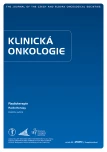Cyberknife boost 5–10 Gy for advanced nasopharyngeal cancer
Authors:
Z. Čermáková 1,2; J. Cvek 1; L. Knýbl 1; E. Skácelíková 1; T. Paračková 1,3
Authors‘ workplace:
Klinika onkologická LF OU a FN Ostrava
1; Ústav epidemiologie a ochrany veřejného zdraví, LF OU, Ostrava
2; Onkologická klinika LF UP v Olomouci
3
Published in:
Klin Onkol 2020; 33(Suppl 1): 60-64
Category:
Original Articles
doi:
https://doi.org/10.14735/amko2020S60
Overview
Background: Nasopharyngeal tumors are a rare disease in our latitudes. Due to anatomical conditions and poor operability, radical radiotherapy with or without chemotherapy is used as a primary treatment modality. Due to the unsatisfactory treatment outcomes, ways to intensify the therapy and increase the curable potential under tolerable toxicity are sought.
Patients and methods: Fourteen patients with advanced nasopharyngeal non-metastatic squamous cell carcinoma, stage II–IVa, were treated at the Department of Oncology of the University Hospital Ostrava in 2010–2014. Eleven (79%) patients were treated with 70 Gy per primary tumor normalized (2 Gy) and affected lymph nodes and with 56 Gy (à 1,6 Gy) for elective lymph nodes by intensity modulated radiotherapy with integrated concomitant boost. Three (21%) patients completed radiotherapy earlier due to complications or general condition. Nine (64%) patients were exposed to concomitant chemotherapy and 6 (43%) received adjuvant chemotherapy. Fourteen (100%) patients underwent cyberboost in the primary tumor and affected lymph nodes (if any) area within a month of radical radiotherapy, five (36%) patients received 5 Gy in one fraction and nine (64%) patients received 10 Gy in 2 fractions.
Results: Out of the 14 patients, local complete remission was achieved in 10 (71%) of them after the treatment. Two (14%) patients had a post-treatment local finding as stationary, local progression with generalization occurred in one case at 18 months and in another patient at 13 months. In one patient with complete remission after the primary treatment, distant metastasis occurred in 43 months at the time of local complete remission of the disease. The average time to progression was 24.6 months. Five (64%) patients achieved 5-year survival with satisfactory toxicity of treatment.
Conclusion: Stereotactic boost after a comprehensive radiation program, with or without addition of concomitant and adjuvant chemotherapy, provides good local control and 5-year survival with satisfying toxicity of the treatment.
Keywords:
cyberknife – Nasopharyngeal carcinoma – cyber-boost – stereotactic radiation – head and neck radiation therapy
Sources
1. 1. Flores AD, Dickson RI, Riding K et al. Cancer of the nasopharynx in British Columbia. Am J Clin Oncol 1986; 9 (4): 281– 291. doi: 10.1097/00000421-198608000-00002.
2. Lee AW, Poon YF, Foo W et al. Retrospective analysis of 5037 patients with nasopharyngeal carcinoma treated during 1976–1985: overall survival and patterns of failure. Int J Radiat Oncol Biol Phys 1992; 23 (2): 261–270. doi: 10.1016/0360-3016 (92) 90740-9.
3. Toya R, Murakami R, Saito T et al. Radiation therapy for nasopharyngeal carcinoma: the predictive value of interim survival assessment. J Radiat Res 2016; 57 (5): 541–547. doi: 10.1093/jrr/rrw038.
4. International Atomic Energy Agency. Implementation of high dose rate brachytherapy in limited resource settings. Vienna: IAEA 2015.
5. Yan JH, Xu GZ, Hu YH et al. Management of local residual primary lesion of nasopharyngeal carcinoma: II. results of prospective randomized trial on booster dose. Int J Radiat Oncol Biol Phys 1990; 18 (2): 295–298. doi: 10.1016/0360-3016 (90) 90092-x.
6. Le QT, Tate D, Koong A et al. Improved local control with stereotactic radiosurgical boost in patients with nasopharyngeal carcinoma. [online]. Available from: https: //www.sciencedirect.com/science/article/pii/S03603016 03001172#BIB7.
7. Co LB, Agas RA, Jacinto JC et al. Radiotherapy dose escalation in the primary treatment of nasopharyngeal carcinoma: a systematic review and meta-analysis. [online]. Available from: http: //anpc.amegroups.com/article/view/4961/pdf.
8. Hara W, Loo BW Jr, Goffinet R et al. Excellent local control with stereotactic radiotherapy boost after external beam radiotherapy in patients with nasopharyngeal carcinoma. Int J Oncol 2008; 71 (2): 393–400. doi: 10.1016/j.ijrobp.2007.10.027.
9. Corvò R. Evidence- based radiation oncology in head and neck squamous cell carcinoma. Radiother Oncol 2007; 85 (1): 156–170. doi: 10.1016/j.radonc.2007.04.002.
Labels
Paediatric clinical oncology Surgery Clinical oncologyArticle was published in
Clinical Oncology

2020 Issue Suppl 1
- Metamizole vs. Tramadol in Postoperative Analgesia
- Metamizole at a Glance and in Practice – Effective Non-Opioid Analgesic for All Ages
- Possibilities of Using Metamizole in the Treatment of Acute Primary Headaches
- Current Insights into the Antispasmodic and Analgesic Effects of Metamizole on the Gastrointestinal Tract
- Spasmolytic Effect of Metamizole
Most read in this issue
- Secondary tumors and radiotherapy
- Nutrition during radiotherapy of cancer patients
- Diet and its effect on prostate cancer, with a focus on plant-based diet
- TSEI in patients with mycosis fungoides – clinical results
